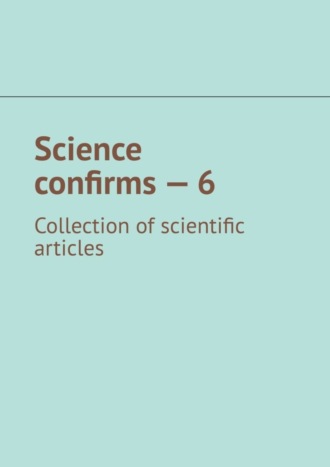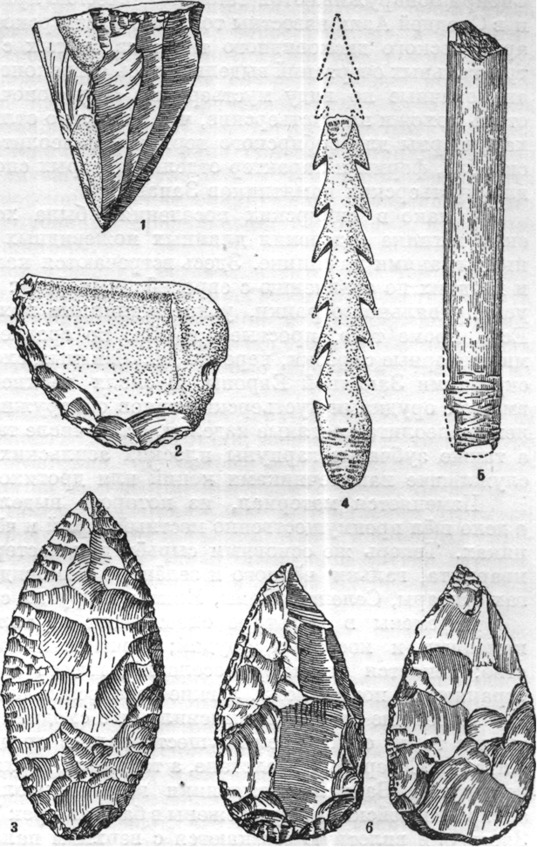
Полная версия
Science confirms – 6. Collection of scientific articles

Science confirms – 6
Collection of scientific articles
Editor Андрей Тихомиров
ISBN 978-5-0059-6700-8 (т. 6)
ISBN 978-5-0059-4957-8
Created with Ridero smart publishing system
Settlement of Siberia
Siberia is part of the Asian territory of Russia from the Urals in the west to the mountain ranges of the Pacific watershed in the east and from the shores of the Arctic Ocean in the north to the elevated steppes of Kazakhstan and the border with Mongolia in the south. The relief of Siberia is very diverse. Within its limits, 4 large geomorphological regions are clearly distinguished: the West Siberian Lowland, the Middle Siberian Plateau, the mountains of Southern Siberia and the mountain system of the northeast (Verkhoyansk-Kolyma Region).
The first traces of human presence in Siberia date back to the Stone Age. The sites of primitive man of the Upper Paleolithic era were discovered on the rivers: Ob, Angara, Yenisei, near Irkutsk, in Transbaikalia. Archaeological research on the Angara and Yenisei showed that a person with a culture very close to the Upper Paleolithic culture of the Russian Plain penetrated into these remote eastern regions at the end of the Solutrean and at the beginning of the Madeleine time. The earliest of the monuments of this kind is a settlement found in the city of Irkutsk, where, along with the bones of rhinoceros, reindeer and other animals of the Quaternary period, ornamented products from mammoth tusks, as well as bone and stone tools, including pointy points, resembling, judging by the description, Solutrean pointy points of Europe, were found. The finds in Bureti, on the Angara River, and in the village of Malta on the Belaya River, a tributary of the Angara, where the remains of typical Upper Paleolithic settlements were discovered, in which hunters of mammoth, rhinoceros, reindeer, wild horses and bulls lived, belong to a somewhat later, Solutreian-Madeleine time. One of the Paleolithic dwellings found in Bureti had the appearance of a straight square with slightly rounded corners. Along the edges of the dwelling, directly above the recess of the floor, the mammoth femurs were vertically dug in. For greater stability, they were wedged in the pits with other bones and limestone tiles. These bones served as pillars or abutments for the roof of the dwelling. A narrow passage led out of the dwelling, also furnished at the edges with symmetrically arranged mammoth femurs. Inside there was a hearth, preserved in the form of a continuous accumulation of ash mass. The roof of the dwelling was made of reindeer antlers. Similar dwellings existed in the neighboring Maltese parking lot on the Belaya River.
Judging by the surviving remains, the dwellings of Bureti and Malta are strikingly close to the winter semi – underground dwellings of the Arctic tribes of the XVII—XVIII centuries. Such were, for example, valkars, or literally «houses from the jaws of a whale», among the settled Chukchi. The skeleton of the valkars, as can be seen from their very name, served as the jaws of a whale, and the walls were made of vertebrae and other large bones of this animal. Described by Russian travelers at the end of the XVIII century. The Valkars of the Chukchi coincide with the Paleolithic dwellings of the Bureti not only in terms of construction techniques, but also in size, shape and in such characteristic details as the presence of pillars wedged in pits for stability with stones.
Inside the dwellings of Bureti and Malta, numerous stone tools close to the Early Madlen ones of Eastern and Western Europe, abandoned or lost by their inhabitants, as well as rich sets of jewelry and art products, including sculptural images of women and flying birds, remained.
On the rocks in the valley of the Lena River, near the village of Shishkin, under the protection of stone cornices, images of extinct animals of the Quaternary period – wild horses and a primitive bull, whose bones are found in the layers of Paleolithic sites, have survived.
However, already in these settlements, which are extremely close in their features to European ones, there are also such cultural features that are not characteristic of the Upper Paleolithic of Europe.
Thorough and extensive excavations of a number of settlements (Afontova Mountain in Krasnoyarsk, Kaiskaya Mountain in Irkutsk, Shishkina Makarova on Lena, Oshurkovo and Nyangi on Selenga, Srostki in Altai) have shown that everywhere in this vast expanse of Eastern Siberia in the Upper Paleolithic, both the forms and the technique of making stone products change dramatically. The bulk of stone tools are represented here by things of a completely unusual type compared to European ones. These are mainly large semi-lunar scrapers with a convex arc-shaped blade, as well as massive chopping tools made of whole oblong pebbles, one end of which is turned by a transverse cleavage into a steep, almost vertical blade, usually only slightly trimmed with upholstery. Very characteristic of settlements of this kind are peculiar products such as skobels, made of whole pebbles, which have a wide wedge-shaped blade formed at one end with wide chips directed from both sides.
Even more unexpected is the fact that in the Upper Paleolithic of Siberia, such techniques and tools are found that in Europe and Central Asia are known only in the Mousterian time. Such, for example, are the nuclei of the archaic disc-shaped type; from the wide and massive triangular plates removed from them, pointed points of the same archaic appearance were made, similar in appearance to Mousterian pointed points. Often such pointy points are so similar to Mousterian ones that they can be distinguished only by the material. The scrapers are also characteristic of the Siberian Upper Paleolithic in their archaic appearance, the forms and character of the decoration of which again repeat the forms specific to the Mousterian monuments of the West.
However, in the Siberian settlements, the Upper Paleolithic technique of separating long knife-shaped plates with regular parallel faces on the back was well known. There are stone products of very perfect and late forms in comparison with European ones: conical and prismatic nuclei of regular cut, narrow and long knife-shaped plates, thin points. There are, in addition, simple and coarse incisors compared to European ones. There are miniature scrapers, often disc-shaped, similar to the later (Azilian) scrapers of Western Europe. In the layers of the Upper Paleolithic settlements of Siberia, along with tools of the Mousterian types, bone products typical of the Upper Paleolithic are also found, including the so-called «wands of chiefs», as well as serrated harpoons of flat Azilian shapes and bone points that served as spearheads or darts.

Upper Paleolithic products from Siberia: 1 – a prismatic – type nucleus; 2 – a flat pebble scraper; 3 – a laurel-shaped tip; 4 – a bone harpoon; 5 – a liner tip; 6 – a pointed tip. 1, 2 and 6 – from Transbaikalia; 3, 4 and 5 – from Verkholenskaya Mountain, near Irkutsk. World History, vol. I, Editor-in-Chief E. M. Zhukov, M., State Publishing House of Political Literature, 1956, p. 79
The material from which stone tools were made is changing. Previously, mainly local gray and black flint, lying in limestones, was used. Now the main raw materials for the masters of the Stone Age are boulders of quartzite, pebbles of «black and green jasper shale, collected on the banks of the Angara, Selenga, Lena, Yenisei and other Siberian rivers.
Changes in culture cover not only the field of the technique of making stone and bone tools; the previously rich art is almost completely disappearing; the nature of settlements is changing; instead of extensive permanent dwellings, light portable tents-plagues are spreading, apparently.
Recent discoveries have revealed that a culture similar to the Upper Paleolithic of Siberia existed at the same time in the foothills of the Urals (on the Chusovaya River), in Altai and in Northern Kazakhstan, as well as along the upper course of the Irtysh River. To the south and east of Lake Baikal, monuments of the Upper Paleolithic culture, identical with the Angara-Yenisei, have been traced in the basin of the Tola and Orkhon rivers (on the territory of Mongolia). Here they closely merge with the Upper Paleolithic of Northern China.
Neolithic monuments are open in all regions of Siberia. In the 3rd millennium BC, the Caucasian tribes living in the foothills of the Sayan and Altai, representatives of the Afanasiev culture, were engaged in cattle breeding and learned how to process metal (copper and bronze), while the population of the more northern forest strip was still at the Neolithic stage. In about the 2nd millennium BC. the entire steppe and forest-steppe strip of Siberia from the Urals to Transbaikalia was inhabited by tribes of pastoralists-farmers who were well acquainted with the extraction and processing of copper and bronze, and some of the West Siberian tribes moved east to the Yenisei (Andronovo culture). At the end of the 2nd millennium BC, newcomers from the southeast, the Mongoloids, joined the indigenous population of the Minusinsk basin, and in the material culture of this time there are some common features with the culture of China (Karasuk culture). The development of cattle breeding contributed to the transition of the South Siberian tribes of the Bronze Age from matriarchy to patriarchy. In the north, the development of social relations was slower, and in some tribes (e.g., the Chukchi, Koryaks, etc.), this transition was significantly delayed. In the 1st millennium BC, bronze tools had already penetrated into certain northern forest areas (which indicates the connection of forest-steppe pastoral tribes with taiga hunters), by the end of this period, iron processing was mastered. Hoeing agriculture grew (in the south, even with the use of artificial irrigation) and cattle breeding, which in the steppe regions took a new form of nomadic.
The 2nd half of the 1st millennium BC is a period of predatory wars, the formation of tribal alliances and the separation of the ancestral aristocracy. It was at this time that the appearance of rich mounds of tribal nobility (Pazyryk culture), containing a large number of imported items and fine examples of local applied art (for example, animal style), dates back to.
The Sayano-Altai tribes of this time are mentioned in Chinese chronicles under the name of the Dinglin, who were conquered by the Huns on the verge of the 3rd and 2nd centuries BC. Since that time, Southern Siberia from Altai to Transbaikalia has become the northern outskirts of the Hunnic possessions. During this period, the influence of Chinese culture on Siberian tribes increased, as evidenced by the finds of Chinese items and coins in Siberia. It is possible that the residence of one of the Hun governors (the former Chinese commander Li Lin) was located near the mouth of the Abakan River, where the ruins of a Chinese building of the 1st century were discovered and examined. Under the
onslaught of the Huns, part of the Gian-Gun tribes migrated to the Yenisei from Northwestern Mongolia, and the Dinlins were partly pushed to the north and northwest, bringing their higher culture there; those who remained on the spot mixed with the newcomers – Mongoloids.
In Western Siberia, as a result of the progress of forest-steppe cattle-breeding tribes (which modern researchers consider to be Ugrians) through the taiga zone to the Far North, a special culture is developing in the lower reaches of the Ob, combining southern and Arctic features. At the same time, the northern archaic culture was still preserved in areas remote from large rivers.
The domination of the Huns in Southern Siberia ended at the beginning of the 1st millennium A.D. The 1st half of this millennium was the era of the formation and domination of new, successive tribal unions (Xianbis, Zhuzhans) in Central Asia. By the 6th century, the Altai Turks of tu-gyu had strengthened. In the middle of the 1st millennium A.D., the peoples of the Yenisei Kyrgyz formed in Prisayanye (the ancestors of the Khakas), Kurykan, or Guligan, in the Baikal region (the ancestors of the Buryat Mongols and Yakuts), Mohe on the Amur and in Primorye (the ancestors of the Amur Tungus, the descendants of ileu) and a number of others. In the 8th century, the Tu-gyu were defeated by the Uighurs, and in the 9th century. In their place, the Yenisei Kyrgyz, who had strengthened by that time, whom the Chinese chroniclers called khagyas (Khakas), moved forward.
In Buryatia, the oldest Bronze Age burial in the Southeastern Sayan was found
Archaeologists of Irkutsk National Research Technical University (IRNTU) have discovered in Buryatia more than 30 ritual structures and the oldest burial of the late Bronze Age in Southeastern Sayan, the press service of the university reports.
«Archaeologists have conducted excavations in the Okinsky district of Buryatia. They found more than 30 ritual structures and the oldest burial of a man of the late Bronze Age in the Southeastern Sayan,» the report says.
The university clarified that the buried man was not lying in a traditional grave pit, but on the surface of the earth under a stone mound surrounded by a ring layout. Red and yellow stones were found next to the deceased’s chest. Scientists believe that the findings have a sacred meaning. Also, the burial differs from those already known to date in the Baikal region by the fact that the skeleton faces the southeast with its head. Similar burials, but with the orientation of the body to the northwest, were found by archaeologists in the north of Khubsugul in Mongolia.
Scientists reported that the bones were poorly preserved, and therefore it is difficult to establish the sex of the buried one – it is known that it was a teenager. The researchers handed over samples of the remains to Canadian scientist Anjei Weber, who will do radiocarbon analysis in the laboratory of Oxford University. This will determine the age of the find.
Archaeologists have also discovered 34 barrow-like structures. The diameters of the embankments are four to six meters. Part of the cenotaphs suffered during the construction of modern houses. Local residents used masonry for construction, which they found in vegetable gardens.
https://ria.ru/20210816/pogrebenie-1745889416.html
In the 2nd half of the 1st millennium AD, the first state formations appeared in Southern Siberia, Turkic writing (Orkhon-Yenisei inscriptions) spread and a fairly high culture was created on the basis of ploughed irrigated agriculture of local tribes and nomadic cattle breeding of the dominant Turkic tribes. During this era, Southern Siberia was connected by trade and political relations with China (the period of the Tang Dynasty). The dominant tribes of the South Siberian state associations subjugated the forest hunting tribes, putting them in the position of dependent «Kyshtyms» and imposing tribute in the form of furs, which were sold in the southern markets.
The state of the Yenisei Kyrgyz in the early 10th century was also weakened by the wars with the Khitans and split into two small khanates, which in the early 13th century were also conquered by the Mongols. The Khakas and Tuvans, after their first conquest by the Mongols (which lasted from 1207 to 1209), repeatedly raised uprisings and were finally conquered only by 1270..
In the middle of the 13th century. The whole of Siberia, except for the extreme northern regions, became part of the Mongol Empire, with Eastern Siberia, including the Sayans, included in the Jagatai (Chagatai) ulus, and western, including Altai, in the ulus of Jochi (Golden Horde). After the collapse of the Golden Horde in the 15th century, the Siberian Khanate (Siberian Yurt, Siberian Kingdom) was formed in Western Siberia. In the 13th-14th centuries, the territory of the Siberian Khanate called «Ibiri» was part of the Jochi ulus, in the 1st half of the 15th century – part of the Uzbek state Abulkhair. Then it was subject to the Nogai murzas. At the end of the 15th century. Ibak (Ibrahim) seized power in Siberia, who is considered the founder of the independent Siberian Khanate, which included the Barabinsk steppe in the south and reached almost to the Arctic Ocean in the north. The capital of the khanate originally became the city of Chingi-Tura (on the site of modern Tyumen). The main core of the Khanate’s population were Turkic-speaking tribes related to Kazakhs and southern Altaians and known as «Siberian Tatars», and the Ugro-Finnish taiga tribes paid tribute to them. The main occupation of the population was nomadic cattle breeding; there were hunting, fishing, and beekeeping. The Khanate consisted of a number of feudal districts (uluses). The khan was at the head of the state. Relying on the support of the Nogai Horde, the Siberian Khanate tried to extend its influence to Kazan. During the reign of Ibak Khan, relations were established with the Moscow Grand Duke Ivan III. At the beginning of the 16th century, power passed to Khan Muhammad from the local dynasty of the «Tayougin family», who moved the capital from Chingi-Tura to the city of Kashlyk. After Russia conquered the Kazan Khanate, the Siberian Khan Ediger in 1555 recognized himself as a vassal of Moscow and pledged to pay an annual tribute. In the 60s of the 16th century. The khan’s throne was seized by the Shiban Prince Kuchum, who stopped paying tribute and seized the river routes going from Siberia to the Urals. As a result of the campaign of Russian military detachments under the command of Ermak, Kuchum was defeated, and its capital was taken in 1581. At the end of the 16th century, several detachments of Russian troops were sent to Siberia under the command of Moscow voivodes, who built a number of fortresses on the territory of the Khanate (Tyumen, Tobolsk, Verkhoturye, Tura) and finally defeated Kuchum in 1598. The annexation of the Khanate to Russia accelerated the development of feudal relations among the peoples of Siberia, promoted the rise of productive forces and contributed to the rapprochement of Siberian nationalities with the Russian people.
The first Russian information about Siberia dates back to the end of the 11th century. Already in the 12th century, the Novgorodians traded with the peoples of the Far North, who needed iron and willingly gave the skins of fur-bearing animals in exchange for iron axes and knives. In the Novgorod charters of the 13th century, the Yugorskaya land is referred to as the Novgorod volost. In the 13th-14th centuries, Novgorod boyars equipped military expeditions for furs beyond the Urals (the largest in 1364). In the middle of the 14th century, Novgorod merchants who traveled beyond the Urals formed into a special corporation – «Yugorshchyna».
After the annexation of Novgorod to Moscow in 1478, the leading role in the movement for the Urals passed to Moscow. Industrial settlements and settlements appeared all along the Pechora way. In the 1st half of the 16th century, the sea route to Siberia was also mastered. At the beginning of the 16th century, the first literary work about the peoples of the Urals and Trans – Urals appeared in Russia – «The Legend of the unknown people in the Eastern country».
The strengthening of the Russian centralized state and the active foreign policy of Ivan IV the Terrible in the East opened the possibility of advancing to Siberia from the Kama Basin. A big role in the colonization of Siberia was played by the Stroganov merchants, who received permission to build fortified towns and hire «willing people» to protect them. Ermak’s campaign was organized from the Stroganov possessions in 1581, which led to the defeat and collapse of the Siberian Khanate. The successes of Ermak’s campaign were consolidated by the military actions of the Moscow voivodes, and at the beginning of the 17th century. The annexation of Western Siberia to the Russian state was completed. The first Russian cities and prisons began to be built: Tyumen (1586), Tobolsk (1587), Pelym (1593), Berezov (1593), Surgut (1594), Verkhoturye (1598), Narym (1598), Mangazeya (1601), Tomsk (1604).
At the beginning of the 17th century, the annexation of Eastern Siberia began. With the Ob river ways and portages, there was an advance to the Yenisei. In 1605, the Ketsky prison was built on Keti, in 1618 on the drag between Ketyu and Yenisei – Makovsky prison, in 1618 on the Yenisei – Yeniseisk, in 1628 – Krasnoyarsk. From the Yenisei, there was progress along the Upper Tunguska (Angara), Podkamennaya Tunguska and Lower Tunguska and along them to the Lena basin. In 1630, the Ilimsky ostrog was built on the Lena drag, in 1631 in the Baikal region – the Bratsky ostrog, in 1632 on the middle Lena – Yakutsk. In 1636, D. Kopylov’s expedition was sent from Tomsk to Lena. By the early 40s, Russian industrialists and explorers in the north came to the Kolyma, and in the south – to the Amur Basin and the Sea of Okhotsk. An outstanding role in the discovery and development of new territories in Siberia was played by Russian explorers – ordinary military and industrial people, often at their own risk, regardless of the government, who organized expeditions to remote eastern and northeastern regions of Siberia. All these expeditions, which were of great importance in the history of geographical discoveries, contributed to the fact that by the beginning of the 18th century. Russian Russian possessions in the north and east of Asia almost reached the borders formed by the Arctic and Pacific Oceans (only Chukotka remained undeveloped); in the southeast, the Russians entered the Amur Basin; in the southwest, in the 1st half of the 17th century, the Russians approached the steppes in the upper reaches of the Irtysh and Ishim and the foothills of the Sayan and Altai. The advance of explorers and service people into the Amur Basin faced resistance from the Manchus who seized power in China. The Russian government sought to establish trade and diplomatic relations with China. According to the Treaty of Nerchinsk in 1689 an agreement on borders was concluded and mutual trade was allowed on the basis of mutual benefit.
Many Khanty, Mansi and other tribes became subjects of the Russian state, as well as the Buryats, who were threatened with complete ruin and physical destruction by the Mongol and Oirat khans. The organization of a unified administration of the peoples of Siberia contributed to the cessation of long and frequent intertribal and inter-tribal wars. As a result of the annexation of Siberia to Russia, the economic and cultural ties of the Siberian peoples with the Russian people were established, which was of crucial importance for the further historical destinies of the peoples of Siberia.
At the end of the 16th-17th centuries, the peasant agricultural colonization of Siberia began. As a result of the strengthening of the enslavement of peasants in the center of Russia, the resettlement movement of peasants to Siberia grew. The Russian peasantry created agriculture here (before that there were only weak beginnings of it in the West Siberian Tatars, southern Mansi, Kachin, Buryats, etc.). The government used free peasant colonization, organizing «sovereign settlements» and planting the peasantry on «sovereign arable land» (processing in favor of the treasury of a certain number of tithes or handing over in the form of a certain rent parts of the crop). The government also forcibly resettled peasants from Russia, from the «black lands», from each plough to a certain number of people, practiced exile «to arable land» and, finally, called for «hunting, walking people» to settle in Siberia. These measures were supposed to lead to the development of agriculture in Siberia, reducing the expensive import of bread from Russia. All the arable and tilled peasantry were in the position of state peasants. Serfdom arose only in the land holdings of churches and monasteries that were founded in Siberia; in the 18th century, peasants were assigned to factories in Altai and Nerchinsk factories.
Конец ознакомительного фрагмента.
Текст предоставлен ООО «ЛитРес».
Прочитайте эту книгу целиком, купив полную легальную версию на ЛитРес.
Безопасно оплатить книгу можно банковской картой Visa, MasterCard, Maestro, со счета мобильного телефона, с платежного терминала, в салоне МТС или Связной, через PayPal, WebMoney, Яндекс.Деньги, QIWI Кошелек, бонусными картами или другим удобным Вам способом.











